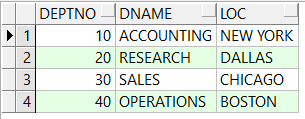数据库(Database)是按照数据结构来组织、存储和管理数据的仓库。数据库现在已经成为数据管理的重要技术,也是计算机的重要分支。由于数据库具有数据结构化,最低冗余度、较高的程序与数据独立性,易于扩展、易于编制应用程序等优点,较大的信息系统都是建立在数据库设计之上的。
数据库管理系统(Database Management System)是一种操纵和管理数据库的大型软件,用于建立、使用和维护数据库,简称 DBMS。它对数据库进行统一的管理和控制,以保证数据库的安全性和完整性。
大部分DBMS 提供数据定 义语言 DDL(Data Definition Language)和数据操作语言DML ,供用户定义数据库的模式结构与权限约束,实现对数据的追加、删除等操作。

1.SQL语言
下面执行的语句都是基于以下三张表:dept 部门表、emp 雇员信息表、salgrade 工资等级表

(1)emp 雇员信息表

(2)dept 部门表

(3)salgrade 工资等级表
(1)SELECT
主外键约束关系:
主表|父表 : 具有主键字段
从表|子表 : 添加一个外键字段
外键字段关联主表的主键字段
外键字段中能够出现的值,必须在主表的主键字段中已有的值
注:命令不区分大小写,字符串内容区分大小写
查询语句:
select *|数据,数据... from 数据源
(1-1)语法:select *(全部列) from 数据源
select * from emp; --查询emp表中的全部数据的所有列
(1-2)查询指定列
语法:select 字段名1,字段名2,... from 数据源
select empno,ename,sal from emp; --查询emp表中所有数据的指定列empno,ename,sal
(1-3)伪列 (整数,表达式,字符串): 表中不存在的字段,但是可查询的内容
整数、表达式、字符串连接符 |
select empno,ename,sal,1 from emp;
(1-4)字段别名: 为查询的结果集中的列起别名(名字默认为字段名或者伪列的值)
语法:select 数据 (as) 别名,数据 别名,数据 别名... from 数据源
select ename as 员工姓名, sal 员工薪资, 202 "教室 编号" from emp;
当别名名字内容比较特别,存在特殊符号,空格,小写名称... 可以在名字的前后添加一对""--->""中的内容原封不动显示
(1-5)表的别名: select 数据 from 表名 别名
注:表的别名不能添加as
select e.ename,e.deptno from emp e;
(1-6)去重: distinct 对结果集中完全相同的数据进行去重
select distinct deptno from emp;
(1-7)虚表 dual(用于计算表达式,显示单条记录的值)
select distinct 123*456 from emp;
select sysdate from dual;
(1-8)null(null 遇到数字参与运算的结果为 null,遇到字符串为空串)
null与数字运算结果为null
select empno,ename,comm,comm+100 from emp;
null值与字符串拼接,结果字符串
select empno,ename,comm,comm||100 from emp;
(1-9)nvl内置函数,判断是否为null,如果为空,取默认值0,否则取字段实际值
nvl(值1,值2) 当值1为null,结果为值2,当 值1不为null,结果为值1
select empno,ename,comm,nvl(comm,0)+100 from emp;
(2)条件查询
条件查询: select 数据字段 from 数据源 where 行过滤条件 --> 满足行过滤条件where的数据被保留在结果集中,只保留指定字段的值select。
执行过程: from -->where-->select
a)、= 、 >、 <、 >=、 <=、 !=、 <>、 between and
b)、and 、or、 not
c)、集合函数 union、 union all、 intersect 、minus
d)、null :is null、 is not null、 --not is null
e)、like :模糊查询 % _ escape('单个字符')
(2-1)between and
工资在2000到3000之间的员工信息
select * from emp where sal>=2000 and sal<=3000;
(2-2) and
检索 工资 2000和3000员工名称 岗位 工资
select * from emp where sal=1500 and sal=3000;
(2-3) 集合函数 union(两个语句求并集结果去重)、 union all(结果不去重)、 intersect (两个结果求交集)、minus(差集)
集合函数 union(去重)、 union all、 intersect 、minus
查询工资大于1500 或 含有佣金的人员姓名
select * from emp where sal>1500
union
select * from emp where comm is not null;
查询显示不存在雇员的所有部门号。
select deptno from dept
minus
select distinct deptno from emp;
(2-4)null :is null、 is not null、 --not is null
存在佣金的员工名称
select * from emp where comm is null;
不存在佣金的员工名称
select * from emp where comm is not null;
select * from emp where not comm is null;
(2-5)like:模糊查询
模糊查询,使用通配符:
%:零个及以上(任意个数的)的字符
_:一个字符
遇到内容中包含 % _ 使用escape('单个字符')指定转义符
查询员工姓名中包含字符A的员工信息
select * from emp where ename like '%A%';
查询员工姓名中第二个字母为A的员工信息
select * from emp where ename like '_A%';
(2-6)in 与 exists
判断指定的字段的值是否与in后面的值列表中的某个值相等,相等就满足
查询到部门名称为 SALES 或 ACCOUNTING的部门编号:
select deptno from dept where dname in('SALES','ACCOUNTING');
在以上两个部门编号的员工信息
select * from emp where deptno in(10,30);
exists(结果集) 存在即合理,存在即合法 --> 看得懂
语法:select 数据 from 数据源 where exists(结果集)
从from的数据源中拿出一条数据,执行where后的判断,判断是否满足条件,看到exists,就观察后面()中的结果集中是否存在数据,存在数据当前数据就满足条件,被保留,不存在不合法
查询销售部的员工信息:
select * from emp where exists(select deptno from dept where dname in('SALES') and dept.deptno = emp.deptno);
(2-7)排序
使用 ORDER BY 排序,排序不是真实改变存储结构的顺序,而是获取的集合的顺序。
- 顺序 :asc(默认) desc
- 多字段: 在前面字段相等时,使用后面的字段排序
- 空排序: 降序为 desc,注意 null 为最后
按工资降序
select * from emp order by sal desc;
null问题
select * from emp order by nvl(comm,0),comm desc; select * from emp order by comm nulls first;
查询雇员姓名,年薪 按佣金排序 默认为升序(asc),降序为desc,注意null为最后
select ename,(sal+nvl(comm,0))*12,comm total from emp order by comm desc;
(3)函数
函数分为系统内置函数 自定义函数(后期学习的 plsql 中定义);了解系统内置函数(方法),重点掌 握 to_date,to_char(字符和日期的转换)根据函数的返回结果,我们将函数分为单行函数和多行函数。
(3-1)单行函数
1.日期函数
注意区分 db数据库时间 ,java应用服务器的时间。以一方为准
oracle以内部数字格式存储日期年月日小时分钟秒
- sysdate/current_date 以date类型返回当前的日期
- add_months(d,x) 返回加上x月后的日期d的值
- LAST_DAY(d) 返回的所在月份的最后一天
- months_between(date1,date2) 返回date1和date2之间月的数目
- next_day(sysdate,星期一) 下一个星期一
--当前时间
select distinct sysdate from emp;
select sysdate from dual;
select current_date from dual;
-- 2天以后日期
-- 日期可以进行+-
select sysdate,sysdate+2 from dual;
-- 所有员工入职的3天后是几号
select empno,ename,sal,hiredate,hiredate-3 from emp;
-- 查询所有员工的试用期期到期(转正的日期) 3个月试用期
select empno,ename,sal,hiredate,hiredate+90 from emp;
--add_months(日期,月数)
select empno,ename,sal,hiredate,add_months(hiredate,3) from emp;
-- 查询所有员工到目前为止一共工作了几个月
select empno,ename,hiredate,months_between(sysdate,hiredate) from emp;
-- 查询当前月的最后一天
select last_day(sysdate) from emp;
-- 下一个星期三是几号
select next_day(sysdate,'星期四') from dual;
2.转换函数(重点)
-- 日期对象 与 字符串之间转换问题
--to_char(日期对象,'模板')
select to_char(sysdate,'yyyy"年"mm"月"dd"日"') from dual;
--to_date(日期字符串,'模板')
select to_date('2021-7-29 15:37:47','yyyy-mm-dd hh24:mi:ss') from dual;
(3-2)多行|聚合|组函数
组函数|多行函数|聚合函数 即多条记录 返回一个结果
- count :统计记录数 count() -->* 或一个列名
- max min: 最大值 最小值
- sum:求和
- avg:平均值
-- 统计一共有几个部门
select count(deptno) from dept;
-- 统计有员工存在的部门总数
select count(distinct deptno) from emp;
-- 统计20部门一共有多少人
select count(1) from emp where deptno = 20;
-- 计算本公司每个月一共要在工资上花费多少钱
select sum(sal) from emp;
--查看30部门的最高工资和最低工资
select max(sal),min(sal) from emp where deptno = 30;
-- 请查询出 20部门的平均工资, 部门编号
select avg(sal),deptno from emp where deptno = 20 group by deptno;
-- 计算出所有员工的奖金总和
select sum(comm) from emp;
(3-3)分组
分组: group by , 将符合条件的记录 进一步的分组,过滤组:having, 过滤组信息 ,表达式同where一致。
步骤顺序:1)、from 2)、where 3)、group 4)、having 5)、select 6)、order by
group by : 分组
1)、select出现分组函数,就不能使用 非分组信息,可以使用group by 字段
2)、group by字段 可以不出现 select 中 ,反之select 除组函数外的,其他字段必须出现在group by 中
having : 过滤组
1. where : 过滤行记录,不能使用组函数
2. having : 过滤组 可以使用组函数
注:
- 一旦分组,分组之后的行为操作都是以组为单位,只能看到有多少组,每组的标签(分组字段的值),但是看不到组中的数据
- 一旦分组,select后面只能查询分组字段或者组函数
- where中不能使用组函数
-- 找出每个部门的最高工资
select deptno,max(sal),min(sal),sum(sal),avg(sal),count(1) from emp group by deptno;
-- 找出20部门和30部门的每个部门最高工资
--1)先过滤后分组
select max(sal),deptno from emp where deptno in(20,30) group by deptno order by max(sal) desc;
--2)先分组后过滤
select max(sal),deptno from emp group by deptno having deptno in(20,30);
-- 求出每个部门员工工资高于1000的的平均工资
select avg(sal),deptno from emp where sal>1000 group by deptno;
-- 求出10和20部门部门的哪些工资高于1000的员工的平均工资
select avg(sal),deptno from emp where sal>1000 and deptno in(10,20) group by deptno;
select avg(sal),deptno from emp where sal>1000 group by deptno having deptno in(10,20);
-- 求出平均工资高于2000的部门编号和平均工资
select deptno,avg(sal) from emp group by deptno having avg(sal)>2000;






















 1083
1083











 被折叠的 条评论
为什么被折叠?
被折叠的 条评论
为什么被折叠?








